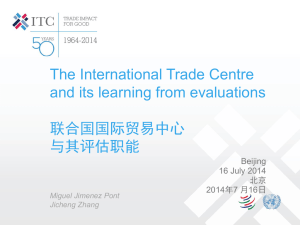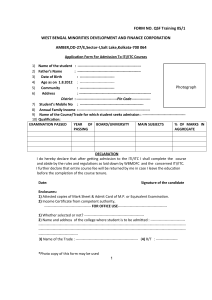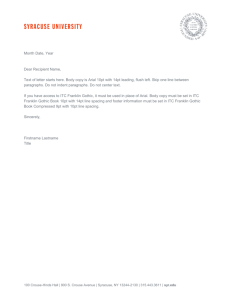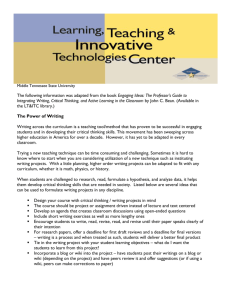Unit 8 The ITC Industry
advertisement
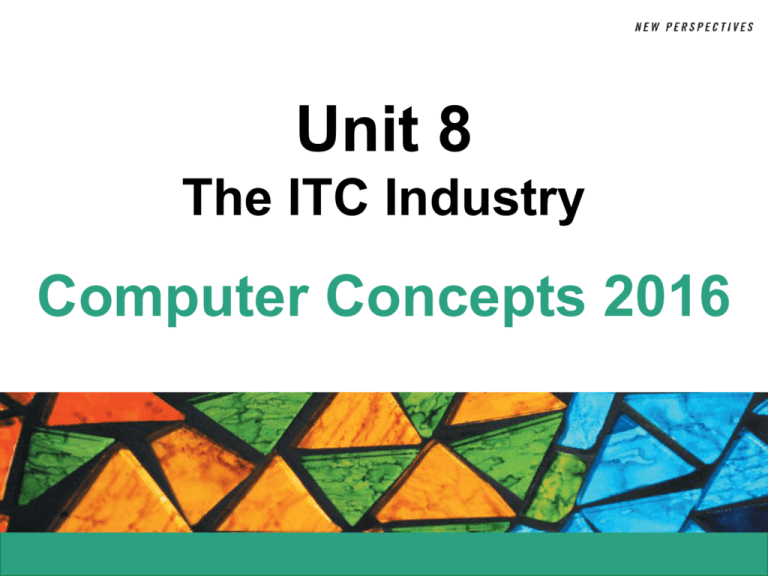
Unit 8 The ITC Industry Computer Concepts 2016 8 Unit Contents Section A: ICT Industry Basics Section B: The Computer Industry Section C: The Telecom Industry Section D: Tech Careers Section E: ICT Laws and Ethics Unit 8: The ITC Industry 2 8 Section A: ICT Industry Basics ICT Core Industries ICT Goods and Services Technology Life Cycles Disruptive Technology ICT and Productivity ICT and National Security Unit 8: The ITC Industry 3 8 ITC Core Industries As the computer industry expanded beyond number crunching to data storage and decision support, the IT (Information Technology) industry evolved The ITC industry is a result of that evolution; a convergence between the IT industry and the telecommunications industry Unit 8: The ITC Industry 4 8 ICT Core Industries Companies and businesses create jobs, develop products, and offer services that drive the economy; they are classified into economic sectors according to the types of goods and services they provide The information industry has three major facets: content, computers, and telecommunications The focus of Unit 8 is the ICT industry, which is made up of businesses that focus on digital equipment, software, and communications technologies Unit 8: The ITC Industry 5 8 ICT Core Industries Unit 8: The ITC Industry 6 8 ICT Core Industries ICT is one of the world’s largest economic sectors; revenues exceed those of the oil and gas industry and the world’s airlines Unit 8: The ITC Industry 7 8 ICT Core Industries The ITC industry has fueled the economies of many countries and was not as deeply affected as some sectors of the economy, during the 2009 global recession The so-called “dot-com bubble” was fueled by a frenzy of online business startups called dot-coms A dot-com bubble that began in the late 1990s burst with devastating effects on ICT stock values; a stock market bubble refers to a sharp rise in stock values that is later followed by a sudden decline Unit 8: The ITC Industry 8 8 ICT Goods and Services In economics, goods are things that can be used or consumed, whereas services are intangible actions performed for a consumer ICT goods and services can be distributed locally, nationally, or internationally, and are purchased by individuals and corporations Consumer goods, such as laptops, are purchased by individuals; Capitol goods are raw materials used by businesses to make consumer goods Unit 8: The ITC Industry 9 8 ICT Goods and Services The terms outsourcing and offshoring are often used interchangeably, but they are slightly different Outsourcing is the use of components or labor from outside suppliers Offshoring relocates business processes, manufacturing and customer support, to lowercost locations in other countries Unit 8: The ITC Industry 10 8 ICT Goods and Services Until the 1990s, ICT companies performed all phases of product development in house Prototyping and mass production moved to Taiwan, then to China Outsourcing and manufacturing efficiencies contributed to falling prices of ICT goods and services Unit 8: The ITC Industry 11 8 ICT Goods and Services Unit 8: The ITC Industry 12 8 ICT Goods and Services Unit 8: The ITC Industry 13 8 Technology Life Cycles The product life cycle (PLC) maps the expected profitability of a product from its inception to its demise Unit 8: The ITC Industry 14 8 Technology Life Cycles To try and track a product’s life cycle, analysts and sociologists devised the following: Moore’s law – Gordon Moore, co-founder of Intel Corp., predicted that technological innovation would double the number of transistors in an integrated circuit every two years without raising its cost Rogers’ bell curve – frequently used to describe patterns in the way consumers adopt technology products; developed by a team of sociologists including Everett M. Rogers Gartner Hype Cycle – represents the position of a product during its life cycle of publicity or “hype”; developed by analysts at Gartner, Inc. Unit 8: The ITC Industry 15 8 Technology Life Cycles Unit 8: The ITC Industry 16 8 Disruptive Technology Disruptive technology displaces an existing business process, market, industry, or product Unit 8: The ITC Industry 17 8 ICT and Productivity In the context of economics, productivity is a measurement of the amount of output that is produced per unit of input Unit 8: The ITC Industry 18 8 ICT and Productivity Unit 8: The ITC Industry 19 8 ICT and Productivity The World Economic Forum produces an annual report on the global influence of the ICT industry and identifies how well countries leverage ICT technologies Unit 8: The ITC Industry 20 8 ICT and Productivity Economist use indicators, such as GDP (gross domestic product), to measure the total output of a nation Between 2011 and 2013 digitization boosted world economic output by US$193 billion and created 6 million jobs during that period These factors are a compelling argument for national investment in digital technologies Unit 8: The ITC Industry 21 8 ICT and National Security Programs of surveillance, espionage and sabotage are carried out today using cyberwarfare hacking tools The ITC industry plays a major role in national security for countries throughout the world Infiltrating and disabling computers storing sensitive corporate, government, or military data could create chaos and temporarily weaken military defenses Unit 8: The ITC Industry 22 8 ICT and National Security Unit 8: The ITC Industry 23 8 ICT and National Security The U.S. Department of Homeland Security identifies six national security functions supplied by the ICT sector: Unit 8: The ITC Industry 24 8 ICT and National Security Cyberwarfare is the use of ICT technology to carry out politically motivated attacks designed to infiltrate, sabotage, or damage an opponent’s information systems and defensive capabilities Recent examples of cyberwarfare include the Stuxnet virus that disabled Iranian nuclear centrifuges The international, non-binding document called the Tallinn Manual, is a cyber equivalent of the Geneva Convention; it sets out rules for conducting and responding to cyberwarfare Unit 8: The ITC Industry 25 8 Section B: The Computer Industry Manual Calculators Mechanical Calculators Computer Prototypes Commercial Computers Personal Computers Unit 8: The ITC Industry 26 8 Manual Calculators A manual calculator is a device that assists in the process of numeric calculations but requires the human operator to keep track of the algorithm An algorithm is the step-by-step process by which numbers are manipulated; even simple paper-andpencil addition requires an algorithm A manual calculator called an abacus was used in ancient Rome, Greece, India, China, and Japan; only as the last century came to a close was the abacus replaced by handheld digital calculators Unit 8: The ITC Industry 27 8 Manual Calculators Unit 8: The ITC Industry 28 8 Mechanical Calculators A mechanical calculator implements algorithms autonomously Mechanical calculators were developed as early as 1623 Schickard’s Calculator had a series of interlocking gears; each of the ten spokes on a gear represented a digit; every time a gear completed a full circle, it moved the next gear one notch to the left to “carry the 1” Unit 8: The ITC Industry 29 8 Mechanical Calculators Charles Babbage’s Analytical Engine was an all-purpose computing device; historians believe that its design embodies many of the concepts that define modern computers, including: Memory A programmable processor An output device User-definable input of programs and data Unit 8: The ITC Industry 30 8 Mechanical Calculators In 1890, Herman Hollerith won the U.S. Census Bureau’s competition to find a way to tabulate the census Hollerith won the competition with a design for an electronic punched card tabulating device The device used cards with designated areas representing data fields, such as “nationality”; once punched, the cards were fed into a reader that used an array of metal rods to electronically read data from the cards, tabulate the results, and display them on a series of dials Unit 8: The ITC Industry 31 8 Mechanical Calculators Hollerith incorporated the Tabulating Machine Company in 1896; in 1924, the name was changed to International Business Machines—better known as IBM Unit 8: The ITC Industry 32 8 Computer Prototypes Figuring out who invented the computer isn’t easy because modern digital computers evolved from prototypes developed between 1936 and 1946 by various individuals and teams The Atanasoff-Berry Computer (ABC) was the first computing device to use vacum tubes instead of mechanical switches as processing circuitry Its design also incorporated the idea of basing calculations on the binary number system Unit 8: The ITC Industry 33 8 Computer Prototypes Even though the ABC is often considered the first electronic digital computer, the work of its inventor was largely ignored Other computer prototypes followed: Z3 – used vacuum tubes and was designed to work with binary numbers; built in Nazi Germany during WWII Harvard Mark I – officially named the IBM Automatic Sequence Controlled Calculator; used decimal rather than binary representation, which is used by today’s computers Colossus – developed in 1943 by British engineers; an electronic device designed to decode messages that were sent between the German High Command and their field commanders Unit 8: The ITC Industry 34 8 Commercial Computers Unit 8: The ITC Industry 35 8 Computer Prototypes ENIAC (Electronic Numerical Integrator and Computer) was designed for the U.S. Army during WWII, but wasn’t finished until three months after the war ended ENIAC was over 100 feet long and 10 feet high and weighed 30 tons! Containing over 18,000 vacuum tubes and consuming over 174,000 watts of power, it was programmed by manually connecting cables and setting 6,000 switches—a process that usually took two days to complete Unit 8: The ITC Industry 36 8 Computer Prototypes ENIAC’s first programmers were a team of six women Unit 8: The ITC Industry 37 8 Commercial Computers A computer called UNIVAC is considered by most historians to be the first commercially successful digital computer At 14.5 feet long, 7.5 feet high, and 9 feet wide, UNIVAC was physically smaller than ENIAC, but more powerful As technology evolved, relay switches and vacuum tubes were replaced with smaller, less powerhungry components Unit 8: The ITC Industry 38 8 Commercial Computers First-generation computers, such as UNIVAC, can be characterized by their use of vacuum tubes to store individual bits of data A vacuum tube is an electronic device that controls the flow of electrons in a vacuum Each tube can be set to one of two states; one state is assigned a value of 0 and the other a value of 1 Unit 8: The ITC Industry 39 8 Commercial Computers Unit 8: The ITC Industry 40 8 Commercial Computers Second-generation computers used transistors instead of vacuum tubes Transistors regulate current or voltage flow and act as a switch for electronic signals Transistors performed functions similar to vacuum tubes, but they were much smaller, cheaper, less power-hungry, and more reliable Unit 8: The ITC Industry 41 8 Commercial Computers Third-generation computers became possible in 1958, when integrated circuits were developed IBM 360 offered integrated circuit technology; the first orders for these computers were filled in 1965 Fourth-generation computers appeared in 1974 with the development of the first general-purpose microprocessor, called the Intel 4004 Intel’s 4004 was smaller than a cornflake but matched the computing power of ENIAC Unit 8: The ITC Industry 42 8 Personal Computers In the 1970s, many hobbyists built their own computer systems based on integrated circuit and microprocessor technologies The Mark-8 and the MITS Altair, where some of the first personal computers to be developed The Altair was sold as a kit for $395; it had no keyboard, no monitor, and no permanent storage device Unit 8: The ITC Industry 43 8 Personal Computers In 1976 Apple Computer Co. was founded by Steve Jobs and Steve Wozniak Apple released several computers during the 1970s & 1980s, including: Apple I – a kit containing a system board with 4 KB of RAM that sold for $666.66 Apple II – featured color graphics, expansions slots, a disk drive, a 1.07 MHz 6502 processor, and 16 KB of RAM for $1,195 Apple Lisa – introduced in 1983, it made computers even easier for the average person to use; its key feature was a graphical user interface; at $10,000 it proved too expensive for most consumers Apple Macintosh – featured a graphical user interface; it became the computer of choice for desktop publishing; cost was $2,495 Unit 8: The ITC Industry 44 8 Personal Computers Unit 8: The ITC Industry 45 8 Personal Computers In 1981, IBM began marketing what it called a personal computer, or PC The $3,000 IBM PC had a 4.77 MHz Intel 8088 processor, 16 KB of RAM, and floppy disk drives The operating system used on these computers was called PCDOS and was created by a young entrepreneur named Bill Gates Unit 8: The ITC Industry 46 8 Personal Computers Unit 8: The ITC Industry 47 8 Section C: The Telecom Industry Telegraph Telephone Radio Cellular Phones Television Unit 8: The ITC Industry 48 8 Telegraph Telegraphy refers to transmitting text or symbolic information over long distances without the use of a living carrier The telegraph was built in 1816 using a cable connected at either end to dials marked with the letters of the alphabet In 1837, U.S. inventor Samuel Morse developed a telegraph system that transmitted data using his Morse code alphabet, a binary encoding system based on dots and dashes Unit 8: The ITC Industry 49 8 Telegraph Unit 8: The ITC Industry 50 8 Telephone A telephone is, very simply, a device that transmits human voices over a distance using cables or airborne signals The first telephone was invented and patented by Alexander Graham Bell in 1876 Telephones evolved through several design form factors, including box phones, and phones with rotary dialers Unit 8: The ITC Industry 51 8 Telephone Unit 8: The ITC Industry 52 8 Telephone A telephone exchange managed connections between callers The world’s first commercial telephone exchange opened in 1877, in Germany Its manual switch board was controlled by a switchboard operator Automated exchanges, developed in 1900, eliminated the need for human operators Unit 8: The ITC Industry 53 8 Radio A radio is a device that sends and recieves sound as electromagnetic waves Like computers, radios originally used vacuum tubes but moved on to new technologies like the transistor Radio technology is the basis for cell phones, Wi-Fi, Bluetooth, and near-field communications (NFC)— all indispensible tools of the digital age Unit 8: The ITC Industry 54 8 Cellular Phones A cellular telephone is a device that uses a lowpower radio transmitter to carry out two-way voice communications Two-way radio technology went portable during WWII In 1984 Motorola brought to market the first cell phone model named the Motorola DynaTAC 8000X; it weighed almost 2 pounds and was more than 12 inches long Unit 8: The ITC Industry 55 8 Cellular Phones Unit 8: The ITC Industry 56 8 Cellular Phones Unit 8: The ITC Industry 57 8 Television Television is a technology designed to send moving images over a distance Beginning with black-and-white sets, televisions progressed to colored programming and eventually transitioned to digital television (DTV) Pay television is a popular subscription service in which consumers pay to receive a selection of television channels Unit 8: The ITC Industry 58 8 Television Unit 8: The ITC Industry 59 8 Section D: Tech Careers Jobs and Salaries Education Certification Resumes Unit 8: The ITC Industry 60 8 Jobs and Salaries Tech sector careers are part of a broad set of information, technology, and communications industries The classification technology workers encompasses jobs, such as: Telephone cable installers Radio broadcasters Computer programmers Web designers Software developers Unit 8: The ITC Industry 61 8 Jobs and Salaries A different classification of tech sector careers comes from STEM (science, engineering, technology, and math) STEM is increasingly used to define an employment sector that includes jobs in: Biology Engineering Math Chemistry Physics Information Technology Unit 8: The ITC Industry 62 8 Jobs and Salaries A third classification of tech sector careers focuses on computer professionals A computer professional is anyone whose primary occupation involves the design, configuration analysis, development, modification, testing, or security of computer hardware or software Many computer professionals work in an IT department—the wing of a business or organization responsible for computer, data, software, and support services; A chief information-officer (CIO) heads the IT department Unit 8: The ITC Industry 63 8 Jobs and Salaries Unit 8: The ITC Industry 64 8 Jobs and Salaries Unit 8: The ITC Industry 65 8 Jobs and Salaries Unit 8: The ITC Industry 66 8 Jobs and Salaries Unit 8: The ITC Industry 67 8 Jobs and Salaries The U.S. Bureau of Labor and Statistics predicts that in the decade 2012-2022, employment in the information and technology sector could grow by 18%, generating 650,000 new jobs An unknown number of these jobs will be outsourced, which may negatively affect U.S. workers but will benefit offshore workers Unit 8: The ITC Industry 68 8 Jobs and Salaries Workers in many industries are interested in becoming a telecommuter who uses available technology to work from home or an off-site location Telecommuters tend to be more productive and work longer hours because they have no commute time and are not interrupted by routine office chatter Finding a job in the IT industry is similar to finding a job in most other industries Use online job listing sites (Tech Jobs, ComputerJobs.com) Network (in person or via email) Use social networking tools (LinkedIn) Unit 8: The ITC Industry 69 8 Education Computer science is only one of many computerrelated degrees that colleges and universities offer According to the Association for Computing Machinery (ACM), there are five major computing disciplines: Computer engineering Computer science Information systems Information technology Software engineering Unit 8: The ITC Industry 70 8 Education Unit 8: The ITC Industry 71 8 Education Unit 8: The ITC Industry 72 8 Education Unit 8: The ITC Industry 73 8 Education Unit 8: The ITC Industry 74 8 Certification Approximately 300 computer-related certification exams are offered in areas of specialty that range from desktop publishing to network installation Certification exams can be divided into several categories, including the following: General computer knowledge Software applications Database administration Networking Computer hardware Computer security Unit 8: The ITC Industry 75 8 Certification Unit 8: The ITC Industry 76 8 Certification Unit 8: The ITC Industry 77 8 Certification Unit 8: The ITC Industry 78 8 Resumes Job seekers need to produce resumes in a variety of formats, including the following: Print Email HTML LinkedIn Online Job service Web portfolio (a hypertext version of your resume) Unit 8: The ITC Industry 79 8 Resumes Unit 8: The ITC Industry 80 8 Section E: ICT Laws and Ethics ICT Laws ICT Ethics Ethical Decision Making Whistleblowing Unit 8: The ITC Industry 81 8 ICT Laws Information technology law is the legal framework that applies to the collection, storage, and distribution of digital information Some of the most significant areas of information technology law include the following: Copyright and intellectual property Domain names Patents Cybercrime Software and computer contracts Privacy Communication Unit 8: The ITC Industry 82 8 ICT Ethics The term professional ethics refers to on-the-job choices and actions that reflect a person’s values Confidentiality is the obligation not to disclose willingly any information that should be kept private Proprietary information includes knowledge about company finances, procedures, products, and research that competitors would find valuable A non-compete clause is designed to prevent employees from divulging proprietary information to competitors Unit 8: The ITC Industry 83 8 ICT Ethics It’s never a good idea to use facilities at work for personal activities unless you have a specific agreement with your employer and your activities do not breach your employment contract Unit 8: The ITC Industry 84 8 Ethical Decision Making Ethical decisions that you make on the job can have longterm consequences for your career and lifestyle, so it is important to approach these decisions seriously Use the following strategies when making decisions at work: Talk to people whose judgment you respect Consider what the most ethical person you know would decide to do Think about what you would do if your actions were made public Look at the problem from the opposite perspective Consult a code of professional ethics Unit 8: The ITC Industry 85 8 Ethical Decision Making A code of ethics is a set of guidelines designed to help professionals thread their way through a sometimes tangled web of ethical on-the-job decisions Some codes of ethics are short and concise, whereas others are long and detailed Most codes contain principles similar to those from the Computer Ethics Institute (CEI) Unit 8: The ITC Industry 86 8 Ethical Decision Making Unit 8: The ITC Industry 87 8 Whistleblowing A widely accepted definition of whistleblowing is the disclosure by an employee (or professional) of confidential information that relates to some danger, fraud, or other illegal or unethical conduct connected with the workplace A whistleblower is someone in an organization who decides to speak out against on-the-job activities that are contrary to the mission of the organization or threaten the public interest Unit 8: The ITC Industry 88 8 Whistleblowing Employee advocates have the following suggestions for reducing the risk of career repercussions that are often experienced by whistleblowers: Examine your motives Try the normal chain of command Collect evidence to back up your accusations Cont… Unit 8: The ITC Industry 89 8 Whistleblowing Record events as they unfold Act ethically Be ready to accept repercussions Establish a support network Consult a lawyer Consider your strategy Unit 8: The ITC Industry 90 Unit 8 Complete Computer Concepts 2016



